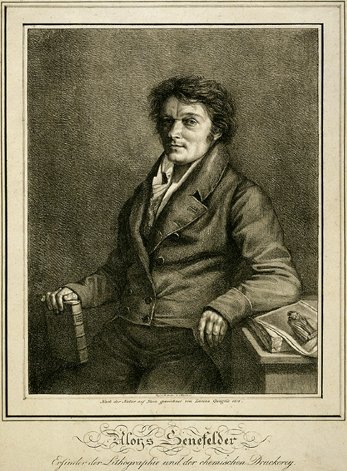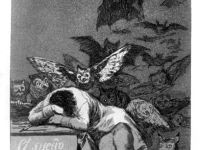
Alois Senefelder (1771-1834),
Lithographic Portrait, 1818
On November 6, 1771, Alois Senefelder, actor, playwright, and inventor of the lithographic printing technology was born.
Background and Early Career
Senefelder was the son of Franz Peter Sennfelder, a Munich court actor from Königshofen in Franconia, and his wife Katharina, née von Volk. Senefelder was born in Prague because his parents gave guest performances there. The young Senefelder studied at Munich and received a scholarship, which enabled him to study jurisprudence at Ingolstadt. The death of his father in 1791 forced him to cease his studies in order to help support his mother and a family of eight sisters and brothers. After attempting to become an actor, he took up dramatic writing, at which he was at first fairly successful with a play called ‘Connoisseur of Girls‘.
Lithographic Printing
In order to publish his plays himself, Senefelder learned printing in a printing office, purchased a small press, and sought to do his own printing. Desiring to publish plays that he had written but unable to afford the expensive engraving of printing plates, Senefelder tried to engrave them himself. Senefelder experimented with relief and intaglio printing processes, using smooth fine-grained stone of Solnhofen limestone as the printing surface. To overcome the difficulty of writing in reverse, he tried writing on paper using a special ink and transferring this to the stone face down, therefore in reverse. Thus he mastered the transfer method. He next turned his attention to the fact of the non-compatibility of grease and water when applied to the stone, leading to the invention of lithography in 1799. Senefelder recorded that one day he jotted down a laundry list with grease pencil on a piece of Solnhofen limestone. It occurred to him that if he etched away the rest of the surface, the markings would be left in relief. He called it “stone printing” or “chemical printing”, but the French name “lithography” became more widely adopted.
In 1818 Senefelder published a full account of the nature and the history of his invention in ‘Vollstandiges Lehrbuch der Steindruckerei‘ . The English translation, ‘A Complete Course of Lithography‘, appeared in 1819 and remained in print into the early 20th century. Senefelder was also able to exploit the potential of lithography as a medium for art. Unlike previous printmaking technique such as engraving which required advanced craft skills, lithography allowed the artist to draw directly onto the plate with familiar pens. Lithography became a popular medium among many artists. Francisco de Goya, Théodore Géricault, and Eugène Delacroix were among the first lithographers. Famous French caricaturist Honoré Daumier was far more prolific, however, making about 4,000 designs, ranging from newspaper caricatures to broadsides printed on a single sheet. Daumier was one of the first lithographers to make use of the process called transfer lithography, by which the tusche drawing is made on paper instead of on the lithographic stone.
Impact
Alois Senefelder’s contribution to printing technology is considered to rank alongside William Ged’s invention of stereotyping, Friedrich Koenig‘s steam press and Ottmar Mergenthaler‘s linotype machine.[7] Senefelder’s innovation made printing more affordable and available to more people, and became important in art and newspaper printing. Senefelder lived long enough to see his process become widely adopted both for art printmaking and as the dominant method of picture reproduction in the printing industry. On February 28, 1834, Alois Senefelder passed away aged 62 in Munich.
Beauvais Lyons: “Stalking Senefelder: The Early History of Lithography”, [8]
References and further Reading:
- [1] Alois Senefelder at Britannica Online
- [2] Alois Senefelder at History of Information
- [3] Alois Senefelder at Wikidata
- [4] Philip B. Meggs: A History of Graphic Design. John Wiley and Sons, Inc. 1998. p 146 ISBN 0-471-29198-6
- [5] Alois Senefelder: A Complete Course of Lithography, Cambridge Publishing Press (2009)
- [6] Johannes Gutenberg – Man of the Milennium, SciHi Blog
- [7] Ottmar Mergenthaler – a Second Gutenberg, Scihi Blog
- [8] Beauvais Lyons: “Stalking Senefelder: The Early History of Lithography”, UTKPRINT @ youtube
- [9] Hyacinth Holland: Senefelder, Alois. In: Allgemeine Deutsche Biographie (ADB). Band 34, Duncker & Humblot, Leipzig 1892, S. 8–23.
- [10] Winfrid Glocker: Senefelder, Johannes Nepomuk Franz Alois. In: Neue Deutsche Biographie (NDB). Band 24, Duncker & Humblot, Berlin 2010, S. 251 f.
- [11] Timeline of 18th century German inventors, via DBpedia and Wikidata






nice post..Thanks
Pingback: Whewell’s Gazette: Year 2, Vol. #17 | Whewell's Ghost
I want to know more about the inventor’s father. Where was Mr Johann Peter Senefelder born.
Thanks.
His father Franz Peter Sennfelder (not “Johann Peter”, also the surname has several different writings, as e.g. “Sennefelder” or “Senefelder”) was born in Königshofen, Lower Franconia.
cf German Wikipedia: https://de.wikipedia.org/wiki/Franz_Peter_Sennfelder
and
Hyacinth Holland: „Senefelder, Alois“, in Allgemeine Deutsche Biographie, herausgegeben von der Historischen Kommission bei der Bayerischen Akademie der Wissenschaften, Band 34 (1892), S. 8–23, https://de.wikisource.org/wiki/ADB:Senefelder,_Alois